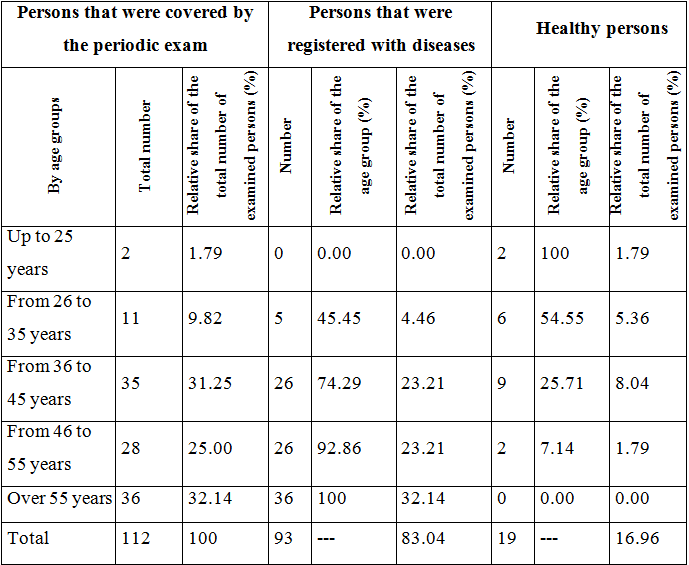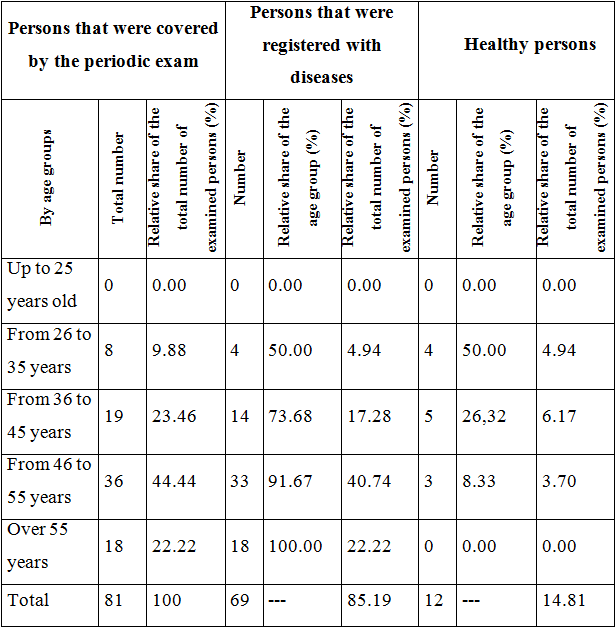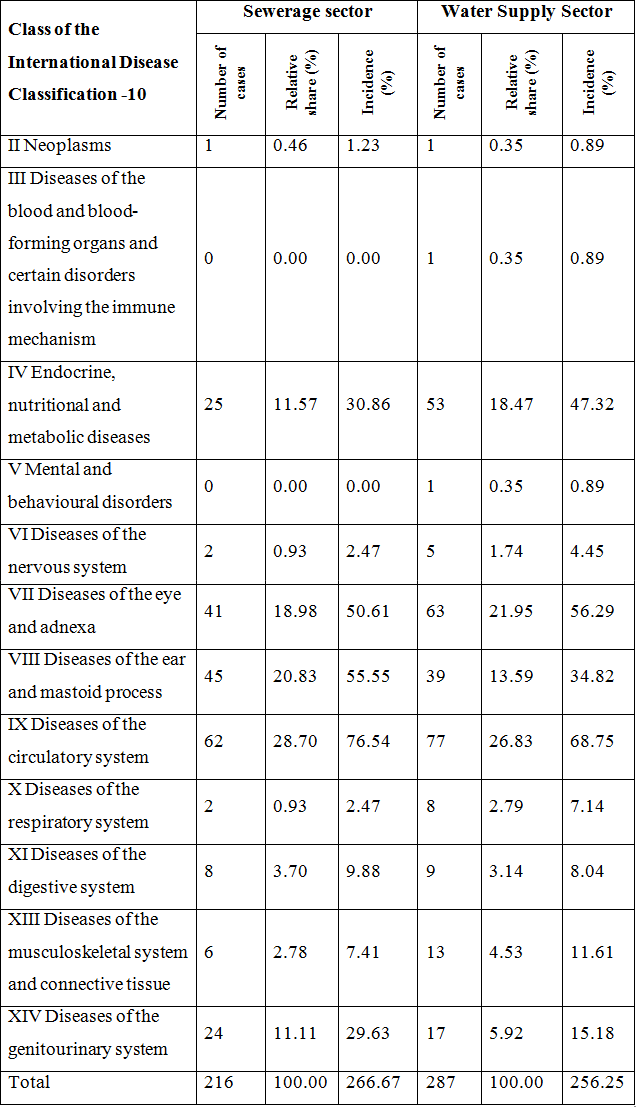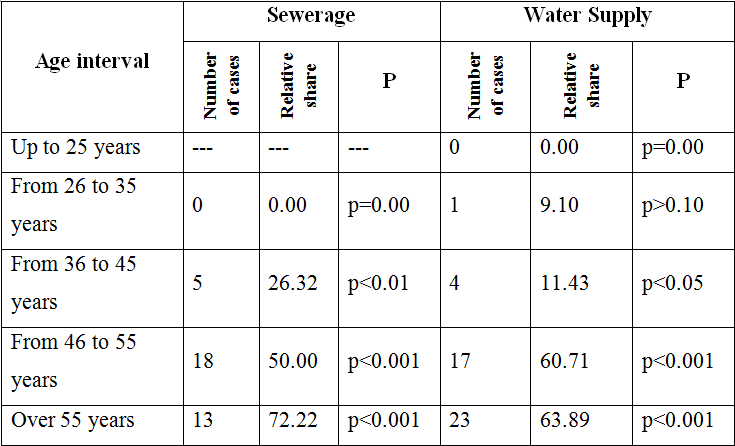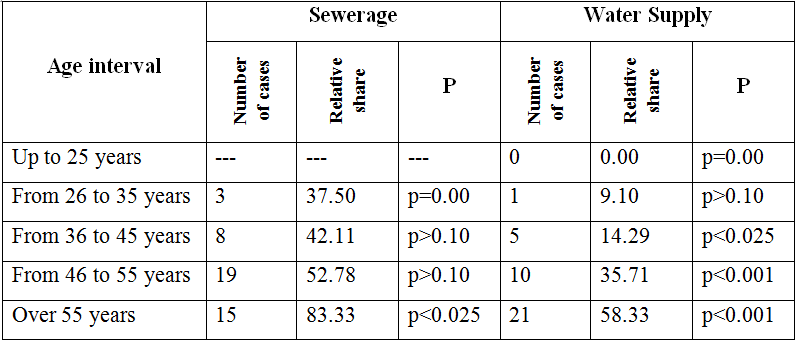АНАЛИЗ РЕЗУЛЬТАТОВ ПЕРИОДИЧЕСКОГО МЕДИЦИНСКОГО ОСМОТРА РАБОТАЮЩИХ В ПРЕДПРИЯТИИ ВОДОСНАБЖЕНИЯ И КАНАЛЛИЗАЦИИ В БОЛГАРИИ
Тосева Е.И.1, Тырновска Т.Х.2, Николов Д.Г.3
1Аспирант, Асистент, Факультет общественого здоровья, Медицинский университет - Пловдив, Болгария, www.elka_toseva@abv.bg; 2Доктор медицинских наук, Профессор, Факультет общественого здоровья, Медицинский университет – Пловдив, Болгария; 3Главный асистент, Медицинский факультет, Медицинский университет – Пловдив, Болгария.
АНАЛИЗ РЕЗУЛЬТАТОВ ПЕРИОДИЧЕСКОГО МЕДИЦИНСКОГО ОСМОТРА РАБОТАЮЩИХ В ПРЕДПРИЯТИИ ВОДОСНАБЖЕНИЯ И КАНАЛЛИЗАЦИИ В БОЛГАРИИ
Аннотация
Разумное использование водных ресурсов и их безопасность от загрязнения является не только экологической проблем, но и существенным фактором устойчивого экономического роста. В Болгарии не существует единной системы мониторинга для состояния здоровья рабочих. Цель этого исследования – анализировать состояние здоровья работающих в одном из крупнейших предприятий Болгарии по доставке и обработке питьевой воды и отходных вод. Постановка и методы: В 2012 году был проведен анализ моментной заболеваемости среди 193 работающих в предприятии „Водоснабжение и Канализация“ (81 в секторе „Канализация” и 112 работающих в секторе „Водоснабжение”). Первичная информация по здоровью собрана из карт для периодического медосмотра. Работающие разделены по критериям: пол, возраст, должность в фирме, направление. Результаты: Общее число зарегистрированных заболеваний - 503 при 193 работающих. Относительная доля зарегистрированных рабочих с отклонениями в состоянии здоровья в секторе „Водоснабжение” - 83.04%, в секторе „Канализация” - 85.19%. С наибольшей относительной долей в обоих секторах - Артериальная гипертония, Глухота, Нарушения рефракции и аккомодации, Ожирение. Заключение: 1. Наблюдается тенденция увеличения относительной доли патологического поражения с увеличением возраста выше 25 лет (p<0.001). 2. Анализ моментной заболеваемости всего лишь за 1 год не показывает убедительной связи между експозицией факторов рабочей среды и зарегистрированными болезнями. Под влиянием факторов в трудовой среде изменения по здоровью наступают за различный период времени (от нескольких месяцев до 5-ти лет). Поэтому считаем, что необходимо проводить анализ моментной заболеваемости за минимальный период 5 лет. Установлена высокая относительная доля работающих с потерей слуха в причинный комплекс которого вероятнее всего включается и высокий уровень шума в рабочей среде. 3. В Болгарии не существует единой статистической системы, которая следит моментную заболеваемость рабочих в целом и по отраслям, независимо от того, что этой деятелностью занимаются службы трудовой медицины.
Ключевые слова: водоснабжение, канализация, моментная заболеваемость, работающие.
Toseva EI1, Turnovska TH2, Nikolov DG3
1PhD student, Physician, Assistant Professor at the Department of Hygiene and Ecological Medicine, Faculty of Public Health, Medical University – city of Plovdiv, Republic of Bulgaria. E-mail for contacts: www.elka_toseva@abv.bg; 2Doctor of Medical Sciences, Physician, Professor at the Department of Hygiene and Ecological Medicine, Faculty of Public Health, Medical University – city of Plovdiv, Republic of Bulgaria; 3Physician, Head Assistant Professor at the Second Department of Internal Medicine, Faculty of Medicine, Medical University – city of Plovdiv, Republic of Bulgaria
ANALYSIS OF THE RESULTS OF THE PERIODIC MEDICAL EXAM OF THE EMPLOYEES IN THE WATER SUPPLY AND SEWERAGE COMPANY IN BULGARIA
Abstract
The sensible use of water resources and their protection from pollution is not only an environmental issue, but also an important factor for sustainable economic growth. In Bulgarian there is no unified system for monitoring the health status of the workers. The aim of this study is to analyse the momentary morbidity rate of the employees in one of the biggest companies for drinking water supply and waste water treatment in Bulgaria. Material and methods: Through 2012. is an analysis of the current prevalence among 193 working in Enterprise "water and sanitation" (81 persons in the wastewater treatment plant for wastewater (sewerage worker, operators, etc.) and 112 operating in the section "the extraction of drinking water". Primary health information collected from health cards for periodic medical examinations. Workers are separated by criteria: sex, age, position in the company direction. Results: the total number of registered diseases - 503 in 193 employees. The proportion of the registered working with abnormal health status in the sector "water supply" is at 83.04% of workers in the sector "Sewage" was 85.19%. With the large relative share in both groups are Arterial hypertension, Conductive and sensorineural hearing loss, Disorders of refraction and accommodation, Obesity. Conclusion: 1. A tendency of pathological affection relative share increase with age increase over 25 years is observed (p<0.001). 2. Momentary morbidity rate analysis for one year only failed to demonstrate a convincing relation between the exposure to occupational environment factors and the registered diseases. Health-related changes occur after various periods of time (from several months to 5 years) as a result of occupational environment factor impact. Therefore, in our opinion a momentary morbidity rate analysis for a minimum period of 5 years is necessary. A high relative share of the employees experiencing hearing loss is established, the causal complex of which most probably included the high level of noise in the occupational environment. 3. There is no integrated statistical system in Bulgaria to follow-up employee morbidity rate as a whole and by sectors, irrespective of the fact that occupational medicine services are being engaged with this activity.
Keywords: momentary prevalence working, sanitation, water supply.
The territory of the Republic of Bulgaria is divided in four Basin Directorates for Water Management. The second largest one is the East White Sea Region, located in a part of the Central South Bulgaria in 10 administrative counties, 92 municipalities, 1772 settlements and 20 Water Supply and Sewerage companies with 24 urban waste water treatment plants. Employee health status monitoring is being exercised by means of periodic medical exams, during which the abilities of the employees to fulfil their obligations in the specific industrial environment conditions having in mind their established health status are being assessed.
Disease occurrence is influenced not only by health culture, age, sex, individual lifestyle peculiarities, etc., but also by factors, such as length of service duration, work process characteristics and occupational environment conditions. The length of service at a particular workplace may be a ‘terrain’ on which any latently existing pathological deviations related to particular risk factors of occupation and environment may appear, or new ones may form. The purpose of this research is to analyse the momentary morbidity rate of the employees in one of the biggest companies for drinking water supply and waste water treatment in Bulgaria.
Materials and methods: The primary information on instantaneous disease rate was collected from the periodic medical exam records, which was regulated by the Bulgarian legislation [1]. The analysis was conducted pursuant to the following indicators: employees’ sex, relative share, age groups: up to 25 years old, from 26 to 35 years old, from 36 to 45 years old, from 46 to 55 years old, over 55 years old and a relative share of the groups, position and trend in which employee works. Data is processed by means of the descriptive statistic and relative share comparison methods.
Results: The periodic medical exam of the employees of the Water Supply and Sewerage company which was conducted in 2012 included 81 persons working in the Sewerage sector (sewerage workers, operators, etc.), whose age was: 48,73±8,83 (X±SD) and 112 persons working in the Water Supply sector, whose age was: 48,20±10,27. 112 males (100% of the employees by sex) have been covered in the Water Supply sector as 45.54% were plumbers (51 persons), 30.36% were pumpers (34), 15.18% were operators (17), 7.14% were working as maintenance personnel - technicians, electricians, fitters, etc. (8), 1.78% worked on other positions (2). The distribution of the participants by sex, age and positions in the Sewerage sector was: 72 males (88.89%) and 9 females (11.11%), 81 persons in total. Of them 51.85% worked as sewerage workers (42 males, 0 females), 17.28% were waste water treatment plant operators (12 males, 2 females), 9.88% were maintеnance personnel - locksmiths, electricians, fitters, etc., (8 males, 0 females), 13.58% were working on managerial positions in direct contact with waste waters – technologist, engineer at the waste water treatment plant, laboratory technician (7 males, 4 females) and 7.01% were working on other positions (3 males, 3 females). The distribution of the persons that were covered by the periodic medical exam is shown in Tables 1 and 2.
Table 1 - Persons who are registered with diseases upon the periodic medical exam in 2012, distributed by age groups in the Water Supply sector
Table 2 - Persons who are registered with diseases upon the periodic medical exam in 2012, distributed by age groups in the Sewerage sector
As demonstrated, momentary morbidity rate had its highest relative share in both followed-up trends in the age group over 55 years, and the lowest relative share - in the group up to 25 years, as the difference had a very high degree of statistical reliability (p<0.001), i.e. the logical expectation for the number of registered diseases to increase with the increase of the age was confirmed. The total number of registered diseases was larger than the number of employees, because more than one disease has been registered in some of them. The structure of the momentary morbidity rate of employees working in both trends is presented in Table 3:
Table 3 - Structure of the momentary morbidity rate of employees in 2012
The results showed that Essential (primary) hypertension had the highest relative share in both groups - 54 (18.8%) of the persons working in Water Supply and 46 (21.30%) of those working in Sewerage (р>0.10) suffered from it, without any determined relation to the age. 37 (12.89%) of the persons working in Water Supply and 45 (20.83%) of those working in Sewerage (р<0.002) suffered from Deafness, related to sound conduction disorders (conductive) and sensorineural hearing loss. The most common Class VІІ conditions pursuant to IDC-10 were Disorders of Refraction and Accommodation, which were found in 45 (15.68%) of the persons working in Water Supply and 36 (16.67%) of those working in Sewerage, (р>0.10). We established a high per cent of the persons suffering from Obesity, Class ІV pursuant to IDC -10 – 47 (16.38%) of the persons working in Water Supply and 21 (9.72%) of those working in Sewerage (р<0.10). It was found that there is a relation between disease rate increase and biological age increase (Table 4).
Table 4 - Structure of the morbidity rate of employees suffering from Disorders of Refraction and Accommodation
The relative share of hearing disorders among the persons working in the Sewerage sector, distributed by age groups was relatively higher in comparison to the share among those, working at the Water Supply sector, which might not be explained only by means of the age-related changes. The results were presented in Table No. 5. The comparison between the group of employees within the 26-35 years interval and the group of employees over 55 years of age pursuant to this indicator, e.g., was confirmed with high degree of reliability – p<0.025.
Table 5 - Structure of the instantaneous disease rate for Deafness, related to sound conduction disorders (conductive) and sensorineural hearing loss
Diseases of the musculoskeletal system and connective tissue formed insignificant part from the momentary morbidity rate structure.
There were no infectious diseases registered among the employees in both groups, despite the employees in the Sewerage sector were exposed to infectious agents. In our opinion, this might be explained by the fact that most infectious diseases had acute onset and as a matter of principle they do not get chronic, due to which employees use a sick-leave with temporary disability and remain unregistered during the periodic medical examinations (instantaneous disease rate).
Discussion: The pilot study of momentary morbidity rate, which was conducted by us in 2012 established a high instantaneous disease rate in both groups of employees, covered by a periodic medical exam, and the tendency for the number of diseases to increase with biological age increase. The high Arterial hypertension disease rate could be explained by a great number of factors, as risk production factors might not be ignored, as well. For example, work in shifts and night work lead to cardiovascular disease incidence increase. According to many authors the combination of this type of work with chemical factors, noise and vibrations increases the risk of cardiovascular disease development by 40% [2, 3, 4]. On the other hand, the registered incidence of this disease corresponded to the official statistics for Bulgaria – arterial hypertension had the highest relative share in comparison to any other diseases among population – 12.8% [5], which demonstrated that production factors were not the only reason. The National Study of Risk Factors related to the Health of the Population aged 25-64 [6] which was conducted in Bulgaria in 2007 established that one of three men and one of four women suffered from the disease. Therefore, in our opinion, the high % of arterial hypertension established was a result of the combined effects of age, employee quality of life and shift work, including night work. The pressure on visual analyser in employees who exercised visual control on the machines in case of insufficient illumination may have aggravating effect on the health status related to the determined high relative share of the Disorders of Refraction and Accommodation. The analogical eye exams which were conducted on the basis of screening visual tests of employees determined that there were unconvincing data on deviations in young persons’ eyesight [7]. Having in mind the fact that some eye diseases occur in young age, before the first employment has begun, their aggravation during work was possible. One example is the astigmatism disease, which is a congenital condition, but falls within the group of the Disorders of Refraction and Accommodation. Practice established that hypermetropia (farsightedness in elderly people) increases with biological age increase. The exposition to noise at work leads not only to changes to hearing analyser, but also to a number of vegetative disorders of the nervous, endocrine, cardiovascular systems, etc. [8, 9]. A high % of the examined employees was found to have Deafness, related to sound conduction disorders (conductive) and sensorineural hearing loss. Technological equipment (mainly electric motors and pumps) in waste water treatment plants generates medium- and high-frequency noise within the range of 125-4000 Hz, with its intensity within the range from 62 dB(А) at control desks up to 98 dB(А) at the pumps of the mechanical sludge removal machines [10]. According to Bulgarian legislation [11] for the occupational disease Neuritis of both hearing nerves (hearing loss over 35 dB) or Practical Deafness (sound pick-up hearing loss 65-90 dB) to be acknowledged, one must prove occupational impact of noise above the limit of minimum 5 years, and for the cases of especially intensive noise (exceeding 100 dB/A) - minimum 6 month on the one hand and on the other hand – a tone threshold audiometry of the better hearing ear, as calculated pursuant to certain methods, must be registered with the examined employee. During the research conducted we did not discuss any relation between hearing loss and occupational conditions due to the lack of preliminary medical information on the employees at the time of their employment at the company. We have not excluded the possibility hearing loss in some of the employees to have resulted of inflammatory ear diseases in a previous period. Age, time of exposure, the degree to which the white finger syndrome is expressed, diastolic arterial pressure is related to hearing loss [12].
Conclusion: 1. A tendency of pathological affection relative share increase with age increase over 25 years is observed (p<0.001). 2. Momentary morbidity rate analysis for one year only failed to demonstrate a convincing relation between the exposure to occupational environment factors and the registered diseases. Health-related changes occur after various periods of time (from several months to 5 years) as a result of occupational environment factor impact. Therefore, in our opinion a momentary morbidity rate analysis for a minimum period of 5 years is necessary. A high relative share of the employees experiencing hearing loss is established, the causal complex of which most probably included the high level of noise in the occupational environment. 3. There is no integrated statistical system in Bulgaria to follow-up employee morbidity rate as a whole and by sectors, irrespective of the fact that occupational medicine services are being engaged with this activity.
References
- Ordinance No. 3 dated 28th February 1987 regulating the Compulsory Preliminary and Periodic Medical Exams of Employees // State Gazette, official edition of the Republic of Bulgaria. – 1987. issue 16.
- Knutsson, A. Health disorders of shift workers // Occupational medicine. – 2003. Vol. 53. P. 103-108.
- Bøggild H., Knutsson A. Shift work, risk factors and cardiovascular disease // Scand J Work Environ Health. – 1999. Vol. 25. P. 85–99.
- Elise E.M.M. van Kempen, Kruize H., Boshuizen H.C., Ameling C.B., Staatsen B.A.M., and de Hollander A.E.M. The Association between Noise Exposure and Blood Pressure and Ischemic Heart Disease: A Meta-analysis // Environ Health Perspect. - 2002. Vol. 110. P. 307–317.
- Borisova А.М. Health Status of Citizens in 2009 and National Health Strategy Implementation: Annual Report of the Minister of Health. Republic of Bulgaria. Ministry of Health. City of Sofia. – 2010. P. 46-47.
- Vassilevsky N., Ivanov L., Tsolova G., Dimitrov P. National behavioral risk factor survey among population aged 25-64, 2007 // Bulgarian Journal of Publik health. – 2009. Vol. 3, № 1. – Р. 7-11.
- Baldasseroni A., Frosini R., Tartaglia R., Carnevale F. The epidemiological aspects of eye screening in occupational medicine // Med Lav. – 1994. Vol. 85, № 2. Р. 99-106.
- Ivanovich Е. Methods and Criteria to evaluate Stress Reactions, Changes to Cardiovascular and Nervous Systems, Individual Noise Sensitivity. In: Tsvetkov D., Angelova M. (editor) Infrasound, Ultrasound, Noise and Vibrations // Sofia: Medicine and Physical Education. – 1995. Р. 91-102.
- Penney P.J. Occupational noise and effects on blood pressure: exploring the relationship of hypertension and noise exposure in workers // Earl CE. AAOHN J. – 2004. Vol. 52, № 11. Р. 476-80.
- Alikbaeva L.A. Scientific Basis to Ensure Hygienic Safety Operation of urban waste water treatment plants with waste water sludge incineration technology // Author’s Summary, 2008. http://medical-diss.com/docreader/7285 (01.04.2014)
- Occupational Disease List // State Gazette, official edition of the Republic of Bulgaria. – 2008. issue 66.
- Kalburova F. Other extraaural changes, changes to hearing sensitivity, correlations of hearing and extraaural changes. In: Tsvetkov D., Angelova M. (editor) Infrasound, Ultrasound, Noise and Vibrations // Sofia: Medicine and Physical Education. – 1995. Р. 103-112.

